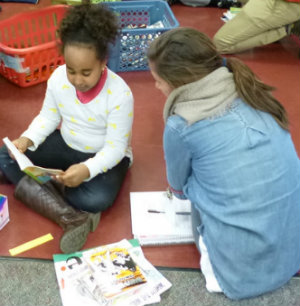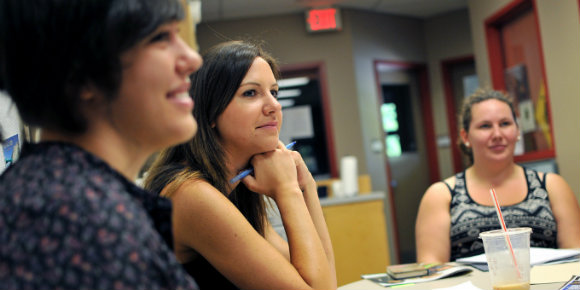Ideas for Staying in the Co-Teaching Groove
A MiddleWeb Blog

Let’s face it, when we are the most excited learners in the room, we not only model what it takes to jump headfirst into the learning process, but we also feel a personal sense of rejuvenation. And it’s a great time of year to tap into the power of the co-teaching models and restore our sense of inspiration.
This year my district has been providing ongoing co-teaching professional development through Lakretz Creative Support Services. Beth Lakretz, Founder and President, recently facilitated another half-day workshop that gave co-teachers time to check in with their instructional decisions, as well as check in with each other.
The workshop held such potential for co-teachers to feel validated, inspired, and rejuvenated. So here I am sharing some of that with you—hoping that you feel the surge of energy to make powerful instructional decisions for all learners (including you and your co-teacher!) in your room.
Here’s the gist—hope you find opportunities to connect and to amplify your sense of self both personally and professionally.
The co-teaching carousel

Co-teachers were given time to move from poster to poster adding an example of how they have been applying each model. Here were some responses. I hope they create a spark for you!
► Alternative Teaching
This option for structuring the process of instruction is perfect when co-teachers are looking to focus on specific needs of students. It allows teachers to be very flexible in the way that they meet the needs of students.
Some examples of success:
• Provide skill-based small group teaching of math concepts with the Common Core math modules
• Reteach concepts during morning routine for small-group extra support
• Any time to reteach, preteach, and provide enrichment
► Parallel Teaching

• Provide options for means of representation. For example, one group needs more visual and auditory, so the concept is taught with SmartBoard or other technologies. And one group needs more hands-on, so the concept taught using more manipulatives and graphic organizers.
• Differentiate to provide slight process alternatives for teaching the same concept. For example, one group would have more processing time.
• Same concept, fewer students, able to provide more direct, specific feedback to students
• Able to see students’ performance and observe progress with steady focus.
► Station Teaching
This model creates a wide array of grouping options to best align students’ needs with instruction. Groups may be arranged heterogeneously, by skill level, randomly, or in any way that meets the needs of your learning targets.
• Good for addressing specific student needs and targeted IEP goals within grade level expectations
• Good for providing movement for students, which can result in more motivated, engaged (and awake!) learners.
• Can lessen any disruptive student behaviors because students are engaged and focused for chunks of time and moving around—and learning!
► Team Teaching

• Takes place naturally in classrooms where co-teachers are in sync. Each adds to the thinking of the other—and magic happens!
• One teacher may read text or questions, while other teacher adds content relevant facts.
• Teachers value and balance out the sharing of each other’s expertise, while students feel the presence and strength of both teachers.
• Proximity of students with teachers can increase student engagement and focus.
Taking the carousel protocol to class
The workshop glided into a group discussion about ways co-teachers may use the carousel protocol in their own classrooms. So what about you? How can you apply the protocol in an upcoming lesson? Check out this site or this ReadWriteThink lesson for some ideas.
Making time for collaboration
The final phase of this workshop allowed co-teachers planning time. Yes. You heard me correctly—co-planning time. What a dream! But before this final phase, co-teachers were given a check-in sheet. Each co-teacher independently evaluated their co-teaching practice based on 13 criteria.
The criteria were based around the roles of each teacher, the planning, and the instructional practices. Each co-teacher rated each criterion on a scale of 1-5 where 5 indicates that something is part of the regular practice—and a cause for celebration! Once each co-teacher completed the evaluation, they shared with their co-teaching partner.
And now for the best part…they discussed their perspectives and created an action plan for taking one small step together toward achieving one shared goal. Cue the music. It’s time to celebrate! Making time for collaboration just makes all co-teachers as effective as possible and keeps us in the co-teaching groove!
For more information about the co-teaching models check out Marilyn Friend’s Co-Teaching Connection
What co-teaching models have you used recently? What one would you like to apply before this school year is over?
Feature image: Three teachers



































